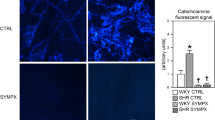Summary
The effect of oral diltiazem 120 mg, on the responses to baroreflex activation and deactivation by phenylephrine and nitroglycerin, respectively, were investigated in normotensive subjects, with simultaneous measurement of plasma catecholamine levels. Diltiazem significantly reduced the tachycardia induced by bolus injections of nitroglycerin and abolished the concomitant increase in plasma noradrenaline. It also significantly decreased the bradycardiac response to phenylephrine infusion. Diltiazem reduced, although not significantly so, the bradycardia induced by boluses of phenylephrine. The overall reduction in baroreflex sensitivity, which might contribute to the limited tachycardiac effect of diltiazem in man, is consistent with the drug-induced attenuation of the sympathetic and also of the parasympathetic components of the baroreceptor reflex.
Similar content being viewed by others
References
Briley M, Cavero I, Langer SZ, Roach AG (1980) Evidence against β-adrenoceptor blocking activity of diltiazem, a drug with calcium antagonist properties. Br J Pharmacol 69: 669–673
Brown MJ, Jenner DA (1981) Novel double isotope technique for the enzymatic assay of plasma catecholamines, permitting high precision, sensitivity and sample capacity. Clin Sci 61: 591–598
Debaisieux J, Théroux P, Waters DD, Mizgala HF, Bourassa MG (1979) Hemodynamic effects of nifedipine and diltiazem after an acute myocardial infarction. Circulation (Suppl II) 60: 82
Downing SE (1979) Baroreceptor regulation of the heart. In: Berne RM (ed) Handbook of physiology. The cardiovascular system, vol 1. American Physiological Society, Bethesda, pp 621–652
Eckberg DL (1980) Nonlinearities of the human carotid baroreceptor-cardiac reflex. Circ Res 47: 208–216
Galzin AM, Langer SZ (1983) Presynaptic α2-adrenoceptor antagonism by verapamil but not by diltiazem in rabbit hypothalamic slices. Br J Pharmacol 78: 571–577
Grossman SH, Davis D, Gunnells JC, Shand DG (1982) Plasma norepinephrine in the evaluation of baroreceptor function in humans. Hypertension 4: 566–571
Heesch CM, Miller BM, Thames MD, Abboud FM (1983) Effects of calcium channel blockers on isolated carotid baroreceptors and baroreflex. Am J Physiol 245: H653-H661
Hossack KF, Bruce RA (1981) Improved exercise performance in persons with stable angina pectoris receiving diltiazem. Am J Cardiol 47: 95–101
Hossack KF, Pool PE, Steel P, Crawford MH, De Maria AN, Cohen LS, Ports TA (1982) Efficacy of diltiazem in angina on effort: a multicenter trial. Am J Cardiol 49: 567–572
Korner PI, West MJ, Shaw J, Uther JB (1974) “Steady-state” properties of the baroreceptor-heart rate reflex in essential hypertension in man. Clin Exp Pharmacol Physiol 1: 65–76
Low RI, Takeda P, Lee G, Mason DT, Awan NA, De Maria AN (1981) Effects of diltiazem induced calcium blockade upon exercise capacity in effort angina due to chronic coronary artery disease. Am Heart J 101: 713–718
Mancia G, Ferrari A, Gregorini L, Leonetti G, Parati G, Picotti GB, Ravazzani C, Zanchetti A (1983) Plasma catecholamines do not invariably reflect sympathetically induced changes in blood pressure in man. Clin Sci 65: 227–235
McLeay RAB, Stallard TJ, Watson RDS, Littler WA (1983) The effect of nifedipine on arterial pressure and reflex cardiac control. Circulation 67: 1084–1090
Millard RW, Gabel M, Fowler NO, Schwartz A (1982a) Baroreceptor reflex sensitivity reduced by diltiazem and verapamil. Fed Proc (Abstr) 41: 7959
Millard RW, Lathrop DA, Grupp G, Ashraf M, Grupp IL, Schwartz A (1982b) Differential cardiovascular effects of calcium channel blocking agents: potential mechanisms. Am J Cardiol 49: 499–506
Nakaya H, Schwartz A, Millard RW (1983) Reflex chronotropic and inotropic effects of calcium channel-blocking agents in conscious dogs. Diltiazem, verapamil and nifedipine compared. Circ Res 52: 302–311
Pickering TG, Gribbin B, Petersen ES, Cunningham DJC, Sleight P (1972) Effects of autonomic blockade on the baroreflex in man at rest and during exercise. Circ. Res 30: 177–185
Robinson BF, Epstein SE, Beiser GD, Braunwald E (1966) Control of heart rate by the autonomic nervous system: studies in man on the interrelations between baroreceptor mechanisms and exercise. Circ Res 19: 400–411
Scher AM, Young AC (1970) Reflex control of heart in the unanesthetized dog. Am J Physiol 218: 780–789
Smith HS, Sleight P, Pickering GW (1969) Reflex regulation of arterial pressure during sleep in man: a quantitative method of assessing baroreflex sensitivity. Circ Res 24: 109–121
Toda N (1969) Effects of calcium, sodium and potassium ions on contractility of isolated atria and their responses to noradrenaline. Br J Pharmacol 36: 350–367
Zelis R, Wichmann T, Starke K (1982) Inhibition of vascular noradrenaline release by diltiazem. Circulation (Suppl II) 66: 143
Author information
Authors and Affiliations
Rights and permissions
About this article
Cite this article
Giudicelli, J.F., Berdeaux, A., Edouard, A. et al. Attenuation by diltiazem of arterial baroreflex sensitivity in man. Eur J Clin Pharmacol 26, 675–679 (1984). https://doi.org/10.1007/BF00541924
Received:
Accepted:
Issue Date:
DOI: https://doi.org/10.1007/BF00541924




